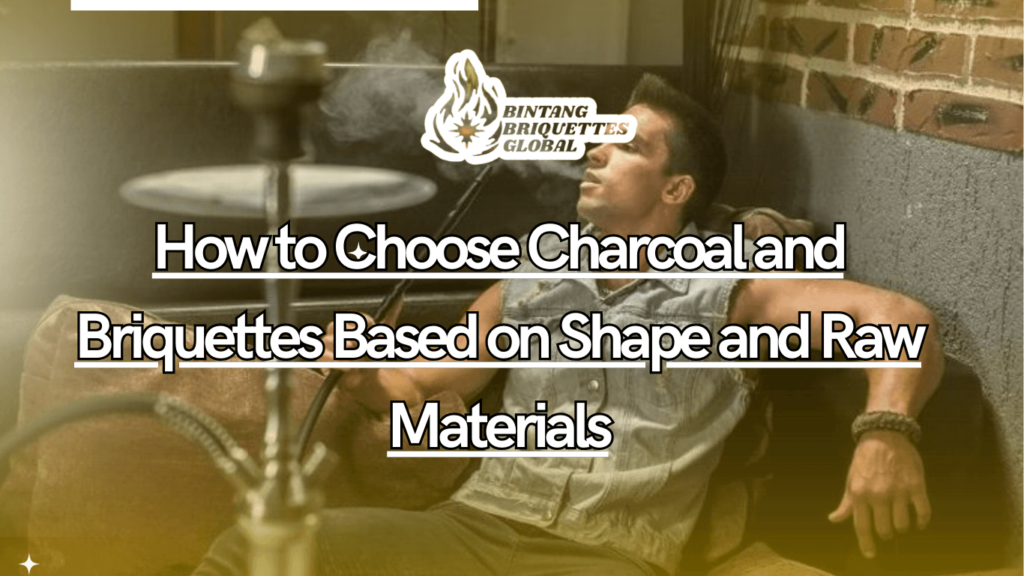Introduction
bintangbriquettes.com – When you choose charcoal and briquettes based on shape and raw materials, you ensure the best performance for your cooking, heating, or smoking needs. Whether for shisha lounges, barbecues, or industrial uses, understanding these factors helps you select the right product for optimal results.
Charcoal and briquettes vary widely in shape, size, and composition. The raw material used affects burning time, heat output, ash residue, and environmental impact. Meanwhile, the shape influences airflow, ignition time, and how evenly the charcoal burns. Understanding these factors helps you make an informed choice that meets your specific needs, ensuring better performance, cost efficiency, and sustainability.
This article will guide you through the essentials of choosing charcoal and briquettes based on their shape and raw materials. We will explore the differences between common raw materials, explain how shape affects functionality, and provide practical advice for selecting the best product for your application.
1. Understanding Charcoal and Briquettes
What is Charcoal?
Charcoal is a carbon-rich material produced by heating wood or other organic materials in the absence of oxygen, a process known as pyrolysis. This removes water, volatile compounds, and impurities, leaving behind a black, porous, carbonaceous material. Charcoal has been used for centuries as a fuel due to its high energy content and clean burn compared to raw wood.
What are Briquettes?
Briquettes are compressed blocks of charcoal dust, sawdust, or other biomass materials combined with binders such as starch or molasses. They are designed to have a uniform size and shape, making them easier to handle, store, and burn consistently.
Key Differences
- Shape and Size: Charcoal often comes in irregular lump shapes, while briquettes are uniform and come in specific shapes like cubes or cylinders.
- Burn Characteristics: Lump charcoal generally burns hotter and faster, whereas briquettes burn more evenly and longer due to binders and shape.
- Raw Materials: Charcoal is often made from hardwood or coconut shells, while briquettes may use charcoal dust mixed with binders.
2. The Role of Raw Materials in Charcoal Quality
Common Raw Materials
- Coconut Shell: Known for high density, long burn time, low ash content, and environmentally friendly sourcing. It is a premium raw material for both charcoal and briquettes.
- Hardwood: Traditional source, burns hot but can produce more ash and sometimes uneven burn.
- Sawdust and Agricultural Waste: Used primarily for briquettes, often mixed with binders. Can be cost-effective but varies in quality.
Impact on Performance
- Burn Time: Dense materials like coconut shell provide longer-lasting fuel.
- Ash Content: Higher quality raw materials produce less ash, reducing cleanup and maintaining airflow.
- Heat Output: Depends on carbon content; high-carbon materials burn hotter.
- Environmental Considerations: Sustainable raw materials, like coconut shell, reduce deforestation and waste.
3. How Shape Influences Charcoal and Briquette Performance
Common Shapes
- Cube: Provides even airflow and uniform burning, popular for BBQ and industrial uses.
- Hexagon: Allows better stacking and airflow, improving combustion.
- Cylinder: Facilitates longer burn times and steady heat.
- Pillow or Oval: Often used in briquettes for ease of handling and packaging.
Shape Effects
- Airflow: Shapes with more surface area and gaps allow oxygen to circulate, promoting consistent combustion.
- Burn Rate: Compact shapes burn slower; irregular lumps may burn faster but unevenly.
- Heat Distribution: Uniform shapes provide steady heat, ideal for cooking or industrial processes.
4. Matching Charcoal and Briquettes to Your Needs
For Shisha
- Prefer coconut shell briquettes due to clean burn, low odor, and long heat duration.
- Shapes like hexagonal or cube briquettes are ideal for steady heat.
For Barbecue
- Lump hardwood charcoal or coconut shell charcoal offers intense heat and quick ignition.
- Cube or pillow briquettes are preferred for longer, consistent cooking times.
Industrial Use
- Briquettes with consistent shape and size ensure reliable fuel for heating or metallurgical processes.
- Raw materials may vary depending on cost and availability.
5. Quality Indicators to Look For
- Moisture Content: Should be below 5% to ensure efficient burning.
- Ash Content: Lower ash means cleaner burn and less residue.
- Fixed Carbon: Higher fixed carbon percentage indicates better fuel quality.
- Certifications: Look for ISO or other quality assurance certifications.
6. The Manufacturing Process and Its Impact
- Raw material selection and preparation affect quality.
- Carbonization temperature and duration influence carbon content.
- Pressing methods and binders affect briquette durability and burn consistency.
- Drying process reduces moisture for optimal performance.
7. Environmental and Health Considerations
- Choose sustainably sourced charcoal to protect forests.
- Avoid charcoal with chemical additives that release harmful fumes.
- Proper ventilation and smoke control improve user safety.
8. Tips for Buyers and Users
- Test burn small samples before large purchases.
- Store charcoal in a dry place to maintain quality.
- Buy from reputable suppliers with transparent sourcing.
9. Case Studies and Examples
- Indonesian coconut shell charcoal’s success in Middle Eastern markets.
- Hardwood charcoal’s popularity in American BBQ culture.
- Sawdust briquettes’ cost advantage in Asian industrial sectors.
Conclusion
choose charcoal and briquettes based on shape and raw materials ensures optimal performance, cost-effectiveness, and environmental sustainability. By understanding these factors, users can confidently select products that perfectly meet their needs—whether for shisha, BBQ, or industrial applications.
For premium quality coconut shell charcoal and custom-shaped briquettes, consider trusted manufacturers who offer private labeling and consistent quality assurance.

